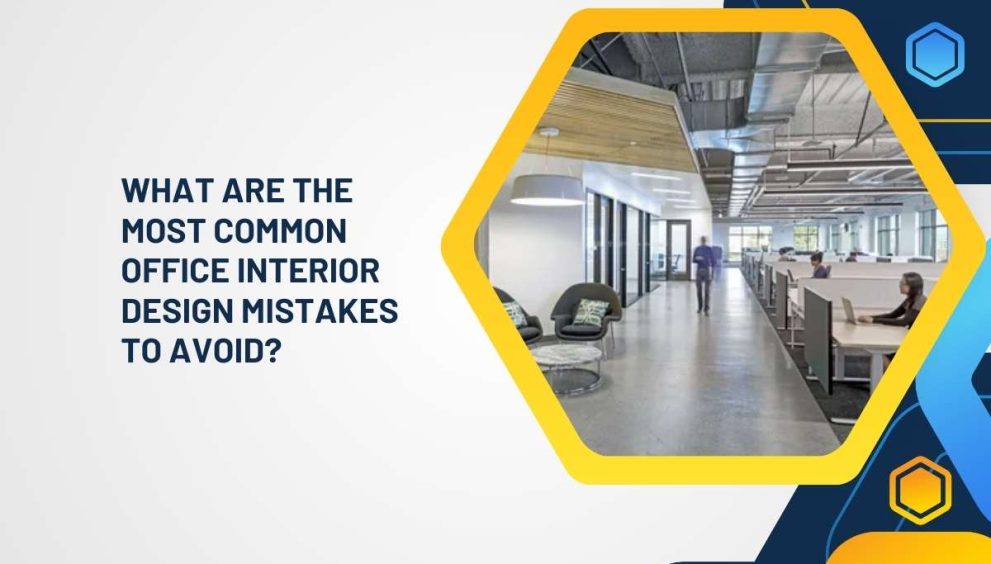What Are the Most Common Office Interior Design Mistakes to Avoid?


Office interior design company is more than just picking out stylish furniture and colorful wall paint. It’s about creating a workspace that enhances productivity, fosters collaboration, and leaves a positive impression on employees and clients. However, many companies often make design mistakes that hinder these objectives. These mistakes can lead to an uncomfortable and inefficient working environment, which can affect employee satisfaction and overall business performance.
In this article, we will explore some of the most common office interior design mistakes and how you can avoid them. By understanding these pitfalls, you’ll be better equipped to design an office that not only looks great but works well for everyone.
1. Ignoring the Needs of Employees
Not Considering Employee Comfort and Functionality
One of the biggest mistakes you can make when designing an office is ignoring the needs of your employees. After all, they are the ones who will be spending the most time in the space. It’s easy to get caught up in choosing trendy furniture and decor, but comfort and functionality should be your top priority.
For example, uncomfortable seating can lead to back pain and reduced focus, which ultimately affects productivity. Similarly, poor lighting can cause eye strain, leading to headaches and fatigue. When designing your office, ensure that you prioritize ergonomic furniture, appropriate lighting, and quiet spaces for focused work.
How to Avoid This Mistake
Take the time to listen to your employees’ needs. You can survey them about their preferences for workspaces, seating, and lighting. Ensure that you provide a range of options, from private areas for deep work to collaborative spaces for brainstorming.
Additionally, investing in ergonomic furniture can pay off in the long run. Adjustable chairs, sit-stand desks, and comfortable lounge areas are all essential to employee well-being.
2. Not Prioritizing Flexibility and Adaptability
Designing a One-Size-Fits-All Office Space
Offices are not static environments; they evolve as businesses grow and change. One common mistake is designing a rigid office layout that cannot adapt to changing needs. A layout that works today may not be suitable in a few months or years, especially if your team expands or your work processes change.
For instance, designing too many individual offices or desks may not allow for future changes, such as the need for more collaborative spaces or larger meeting areas.
How to Avoid This Mistake
Plan for the future by designing flexible spaces. Modular furniture, movable partitions, and open-plan areas that can be easily reconfigured allow your office to evolve with your business needs. Ensure that your office layout can accommodate changes in technology, team size, and work methods.
Flexible office spaces are also beneficial for employees who work in various roles or departments, as they allow for easy collaboration.
3. Focusing Too Much on Aesthetics Over Practicality
Forgetting the Functionality of the Design
While aesthetics play an important role in creating a visually appealing workspace, it’s essential not to focus solely on looks at the expense of functionality. Many businesses make the mistake of choosing trendy furniture, bold colors, or artistic designs without considering how these choices will impact employees’ productivity.
For example, you might choose a beautiful, modern desk that looks great in photos but doesn’t provide enough storage space for important files or technology. Or you might choose bright, vibrant colors that could make the office feel too stimulating, hindering concentration and focus.
How to Avoid This Mistake
Strike a balance between aesthetics and practicality. Choose office furniture that not only looks good but also serves a functional purpose. Ensure that workstations have enough storage, and desks are equipped for technology needs. When selecting colors and decor, keep in mind the mood you want to create. Choose colors that inspire creativity without being overwhelming. Neutral tones with accents of color tend to work well in most offices.
4. Poor Lighting Choices
Not Considering Proper Office Lighting
Lighting is one of the most important elements of office interior design. Poor lighting can affect mood, productivity, and even health. Bright fluorescent lights can make a space feel cold and uninviting, while insufficient lighting can strain eyes and lead to fatigue. Yet, many companies make the mistake of not prioritizing the quality and placement of lighting in their offices.
How to Avoid This Mistake
Consider using a combination of ambient, task, and accent lighting to create a well-lit, comfortable environment. Use task lighting, like desk lamps, to provide focused light for specific tasks. For general lighting, opt for soft LED lights that provide even illumination without being too harsh. Make sure that natural light is maximized by placing desks near windows if possible.
If natural light is limited, use light-colored furniture and walls to help reflect light around the office and avoid a gloomy atmosphere.
5. Overcrowding the Space
Cluttered and Crowded Office Layouts
In an effort to fit as many desks and workstations into the available space as possible, some businesses make the mistake of overcrowding their offices. A cluttered space can make employees feel cramped and hinder their ability to focus or collaborate. Overcrowding can also lead to safety hazards, as it becomes difficult to navigate through the office.
How to Avoid This Mistake
While maximizing space is important, it’s equally important to ensure that there is enough room for people to move freely. Leave enough space between desks and create clear pathways for movement. It’s also essential to include areas for relaxation or informal meetings where employees can take a break or have discussions in a less formal setting.
Consider incorporating open spaces or even lounge areas where employees can unwind or hold casual meetings. This will prevent the office from feeling too tight and improve overall employee satisfaction.
6. Lack of Storage and Organization
Disorganized Office Spaces
An office that lacks adequate storage can quickly become disorganized and messy. Piles of paperwork, unused equipment, or cluttered desks can cause stress and make it difficult for employees to stay focused. Without sufficient storage, employees may spend more time searching for items or cleaning up their workspace, rather than getting their work done.
How to Avoid This Mistake
Design an office layout that includes plenty of storage options, such as filing cabinets, shelves, and storage rooms. Encourage employees to keep their desks tidy and organized by providing them with the necessary tools to do so. Digital tools like cloud storage and project management software can also reduce the need for physical paperwork, cutting down on clutter.
Make sure that storage is accessible and placed strategically throughout the office, so employees don’t have to waste time looking for supplies or files. This can help reduce distractions and improve workflow.
7. Failing to Incorporate Brand Identity
Ignoring the Company’s Brand
Another common mistake in office interior design is failing to incorporate the company’s brand identity into the space. Your office should reflect your company’s values, culture, and personality. A generic office design may fail to communicate your brand effectively and could make your office feel disconnected from the work you do.
How to Avoid This Mistake
Incorporate your company’s colors, logos, and brand message into the office design. This could include wall art that highlights your company’s mission, branded colors in furniture or decor, or creating a feature wall with your company’s logo. A strong brand presence in the office helps employees feel connected to the company and reinforces your brand message to clients and visitors.
Additionally, consider creating a workspace that reflects your company’s culture. If your business is creative and collaborative, open spaces with flexible seating arrangements may work well. For a more traditional company, a formal design with defined areas may be a better fit.
8. Underestimating the Importance of Acoustic Design
Neglecting Sound Control
Poor acoustics can be a major issue in an office, especially if you have a lot of open spaces. High noise levels can be distracting and make it difficult for employees to focus on their tasks. It can also reduce the quality of meetings, as background noise can interfere with communication.
How to Avoid This Mistake
Consider adding acoustic panels, carpeting, or ceiling tiles to reduce noise levels and create a more peaceful working environment. When designing the layout, think about where noise-sensitive activities take place, such as meetings or phone calls, and create separate spaces for these activities. If you have an open-plan office, include private pods or quiet zones where employees can escape the noise and concentrate.
9. Overlooking the Role of Technology
Failing to Integrate Modern Technology
Technology plays a crucial role in modern offices, but many companies make the mistake of not properly integrating it into the design. Without proper electrical outlets, cable management, or space for modern tech, your office can quickly become inefficient and outdated.
How to Avoid This Mistake
Ensure that your office design accounts for all technological needs. This includes adequate power outlets, charging stations, and cable management systems to keep cords out of sight. When choosing furniture, select options that allow for easy integration of technology, such as desks with built-in power strips or media consoles for storing devices.
Conclusion
Designing an office space that is both functional and aesthetically pleasing is no easy task. Avoiding common office interior design mistakes can help you create a workspace that promotes productivity, employee satisfaction, and your company’s brand identity. By considering the needs of your employees, planning for flexibility, and prioritizing functionality, you’ll be able to create an office that works for everyone.
For More Insightful Articles Related To This Topic, Feel Free To Visit: bloggingshub.













